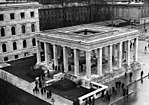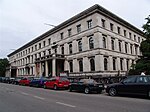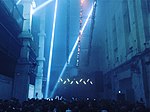Brown House, Munich
1828 establishments in Germany1947 disestablishments in GermanyBuildings and structures demolished in 1947Buildings and structures in Germany destroyed during World War IIBuildings and structures in Munich ... and 4 more
Headquarters of political partiesHouses completed in 1828Use shortened footnotes from February 2021World War II sites in Germany

The Brown House (German: Braunes Haus) was the name given to the Munich mansion located between the Karolinenplatz and Königsplatz, known before as the Palais Barlow, which was purchased in 1930 for the Nazis. They converted the structure into the headquarters of the National Socialist German Workers' Party (Nationalsozialistische Deutsche Arbeiterpartei; NSDAP). Its name comes from early Nazi Party uniforms, which were brown (see Political colour#Brown for details). Many leading Nazis, including Adolf Hitler, maintained offices there throughout the party's existence. It was destroyed by Allied bombing raids during World War II.
Excerpt from the Wikipedia article Brown House, Munich (License: CC BY-SA 3.0, Authors, Images).Brown House, Munich
Max-Mannheimer-Platz, Munich Maxvorstadt
Geographical coordinates (GPS) Address Phone number Website Nearby Places Show on map
Geographical coordinates (GPS)
| Latitude | Longitude |
|---|---|
| N 48.145277777778 ° | E 11.5675 ° |
Address
NS-Dokumentationszentrum München
Max-Mannheimer-Platz 1
80333 Munich, Maxvorstadt
Bavaria, Germany
Open on Google Maps










